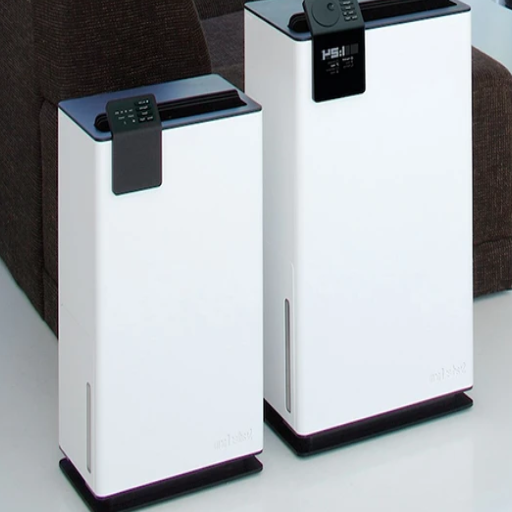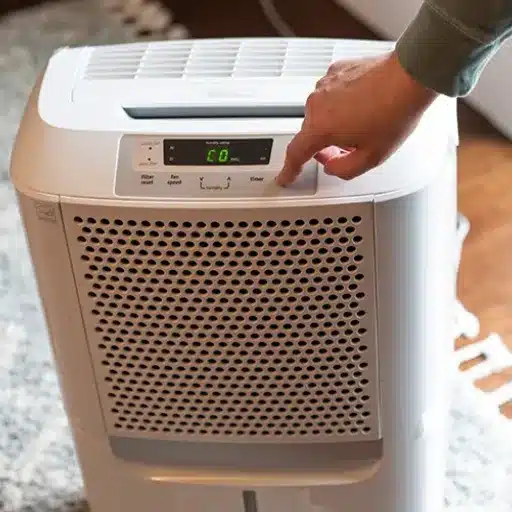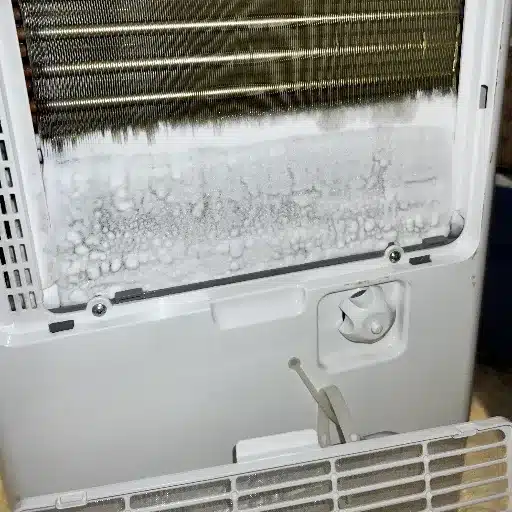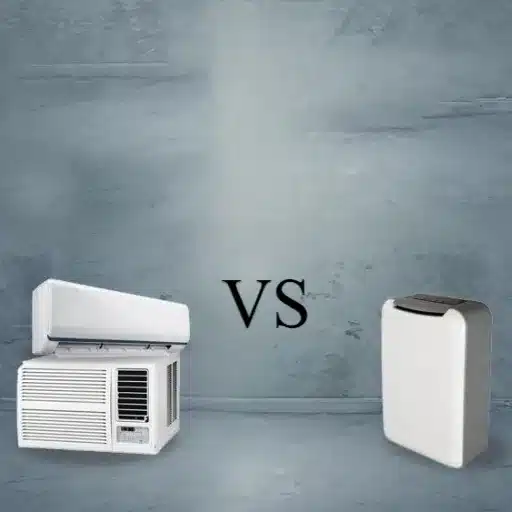Controlling moisture levels is a critical aspect of maintaining efficient operations and preserving the integrity of industrial spaces. Excess humidity can lead to equipment corrosion, compromised product quality, and the proliferation of mold and bacteria, ultimately resulting in financial and structural setbacks. This makes industrial dehumidifiers an essential investment across a wide range of sectors, from manufacturing and logistics to pharmaceuticals and food processing. This article serves as a comprehensive guide to selecting the ideal industrial dehumidifier for your specific needs. By understanding key factors such as capacity, energy efficiency, and environmental requirements, you’ll be equipped to make an informed decision that ensures optimal performance and long-term reliability.
What to Consider When Buying an Industrial Dehumidifier?
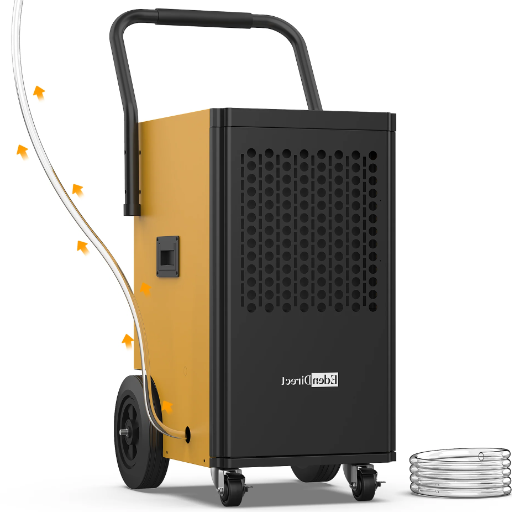
How does a dehumidifier work?
A dehumidifier works by the operation of extracting excessive moisture from the air to keep humidity levels in check. The process starts with a fan that draws in air. The air passes over cooling coils that reduce the temperature of the air, causing water vapor to become liquid through condensation. This liquid then either gets collected in tanks or drained away through a hose by the dehumidifier tank design. Air now free of moisture is reheated to reattain its initial temperature before being discharged into the surroundings.
Dehumidifiers primarily come in two types for industrial refrigerant and desiccant. The refrigerant dehumidifiers utilize a cooling system to remove water from the air and are thus the most effective in conditions having high humidity with moderate temperature. In contrast, desiccant dehumidifiers take their name from the drying material used to absorb moisture from the air, be it silica gel or something else. Such dehumidifiers are ideal for low-temperature or highly dry environments since they maintain their efficiency in diverse working conditions.
A dehumidifier’s efficacy and performance depend, to a great extent, on its capacity and airflow rate, as well as on conditions of operation. It is essential to choose the relevant kind of dehumidifier to guarantee successful moisture control, to ward off damage to equipment or product, and to uphold a safe and compliant workplace atmosphere. Having learned this, users may put operational principles into use, helping them optimally manage humidity-related issues in diverse industrial applications.
Factors to consider for large spaces
Next on the agenda is the selection of a dehumidifier for larger spaces, with its capacity being the priority, usually stated in terms of pints of moisture removed per day. The consideration would go such that the higher the capacity, the more it suits environments with higher moisture levels or larger square feet. Thus, making sure to match the performance with the demand of the space ensures an efficient work strategy as well as a longer lifespan for the unit.
The second key factor relates to the airflow capacity measured in cubic feet per minute (CFM). The bigger the areas, the larger the models should be in CFM compatibility for even distribution and adequate humidity controls across the whole space. Inadequate airflow produces uneven moisture levels, which will undermine the functioning of the dehumidifier and deliver subadequate ambience.
The environmental conditions, such as temperature and relative humidity, should be considered as well. Cold climates or any sporadic temperature environment require a low-temperature model with auto defrost functionality so ice does not form. In addition, placing the equipment is just as important for dehumidifier functioning, so it should be placed in the center of the area, alongside minimal obstructions to the airflow path. Proper evaluation of these factors will ensure efficient moisture control and enhance the longer life of the equipment.
Understanding humidity levels and control
Humidity levels refer to the concentration of water vapor present in the air, which can be measured as either absolute or relative humidity. Relative humidity (RH) is generally considered more practical, is measured as a percentage, and indicates the water vapor in the air relative to the maximum it can hold at a given temperature. Ensuring that humidity is kept between 30% and 50% RH is good for comfort, health, and preserving household items.
Effective humidity control involves keeping moisture levels in check to avoid mold growth, condensation, and corrosion of materials. Ventilation, use of dehumidifiers, and controlling moisture-generating activities like cooking or showering are some ways it can be controlled. A continuous reading from a hygrometer ensures that proper levels are measured and adjusted as necessary.
Proper humidity offers a healthy living environment, reduction of allergens, and protection for wood structures, fabrics, and electronics against damage from excessive moisture. The measures needed to make this a reality work to create a proper, controlled environment that suits each individual.
Top Industrial Dehumidifiers on the Market
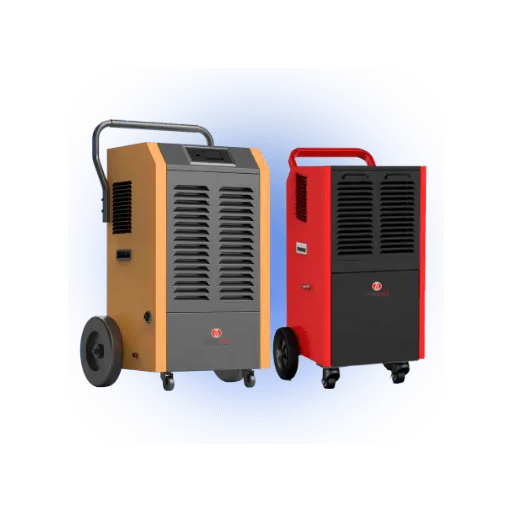
Features of the best models
- High Moisture: Extraction Capacity: Drastic amounts of moisture are removed by the industrial-grade dehumidifiers daily. For instance, they can remove up to 200 pints of moisture per day in extreme humidity cases, rendering them ideal for warehouses or industrial plants.
- Energy Efficiency: Advanced dehumidifiers offer energy-efficient technologies such as variable-speed compressors and environmentally friendly refrigerants to minimize power consumption. Energy Star-certified units, therefore, promise low operating costs without compromising on performance.
- Durability and Robust Construction: Industrial dehumidifiers have corrosion-resistant parts, stainless steel cases, and highly durable material construction that adds to their life span. These machines can also tolerate severe environmental conditions such as high humidity and airborne contaminants.
- Smart Controls and Monitoring: Digital control, Wi-Fi availability, and remote monitoring are some options available. Integrated sensors monitor humidity levels in real time, and some devices allow users to program cycles to work optimally.
- Portability and Installation: Flexibility Industrial dehumidifiers are usually fitted with features to help with transportation, such as heavy-duty casters and ergonomic handles. This flexibility extends to installation options, which can allow for either ducted or standalone configurations, thereby adapting to any layout of the space.
Each of these features has been designed to guarantee performance, operational efficiency, and long-term reliability to ensure that various industrial environments are optimized for comfort.
Comparing commercial dehumidifiers
Drum dehumidifiers would themselves include Dri-Eaz, Phoenix, Abestorm, Aprilaire, BlueDri, and Quest models, with each featuring some unique specification for the various industrial needs.
|
Brand |
Model |
Capacity |
Area |
Feature |
Price |
|---|---|---|---|---|---|
|
Dri-Eaz |
Revolution LGR |
139 Pints |
2000 SqFt |
Compact |
$2,149 |
|
Phoenix |
200 MAX LGR |
133 Pints |
1300 SqFt |
Portable |
$3,999 |
|
Abestorm |
Hurricane 850 |
180 Pints |
2300 SqFt |
Auto-restart |
$832 |
|
Aprilaire |
1870 XL Pro |
130 Pints |
3900 SqFt |
Remote Ctrl |
$2,208 |
|
BlueDri |
BD-76 |
150 Pints |
1300 SqFt |
Durable |
$1,200 |
|
Quest |
Dual 155 |
155 Pints |
1300 SqFt |
Ducted |
$2,700 |
Benefits of LGR dehumidifiers
LGR dehumidifiers, or Low Grain Refrigerant Dehumidifiers, are specialized tools designed for efficient moisture removal, even under challenging environmental conditions with high humidity. Their advanced feature set and premium performance have, therefore, made them a must for restoration, drying, and humidity control applications. Below are five benefits of LGR dehumidifiers:
- Large Moisture Removal Capacity: An LGR dehumidifier is capable of handling severe moisture loads and is suited for large areas and water damage restoration. The Abestorm Hurricane 850, for example, can take 180 pints of moisture per day from an area measuring upwards of 2300 square feet, depicting the efficiency of such a machine in high-demand applications.
- Better Efficiency in Adverse Scenarios: These machines are designed to provide maximum efficiency in extreme operational conditions, where less sophisticated units tend to fail. The Dri-Eaz Revolution LGR is compact yet can extract 139 pints of moisture per day over an effective area of 2000 square feet.
- Duration and Reliability: LGR dehumidifiers are designed for heavy-duty applications and therefore offer longevity. The BlueDri BD-76 is a good example of such dehumidifiers with the sturdy structure to stand the force of long heavy-duty application, removal of moisture to the tune of 150 pints in an area of 1300 square feet.
- Advanced Functionality for User Conveniences: Several of these machines integrate modern technology, incorporating features such as auto-restart, remote control, and even ducting. The Aprilaire 1870 XL Pro, for example, allows the user to control the system via remote control even across a 3900 square foot area. Therefore, the Quest Dual 155 can be ducted for flexible placement in 1300 square foot applications.
- Price-Performance Advantage: The LGR systems are the foremost candidates to ensure that you get a bang for your buck, given that they will reduce your bills through their energy efficiency and require minimal maintenance on account of their durability. Here’s the Abestorm Hurricane 850 for just $832 with an industry-best performance ability of 180 pints per day over 2300 square feet.
By these advantages, the LGR dehumidifiers are indispensable assistive tools for professionals in water damage restoration and climate control, and also for residential and commercial places demanding superior humidity control solutions.
How to Shop for Industrial Dehumidifiers
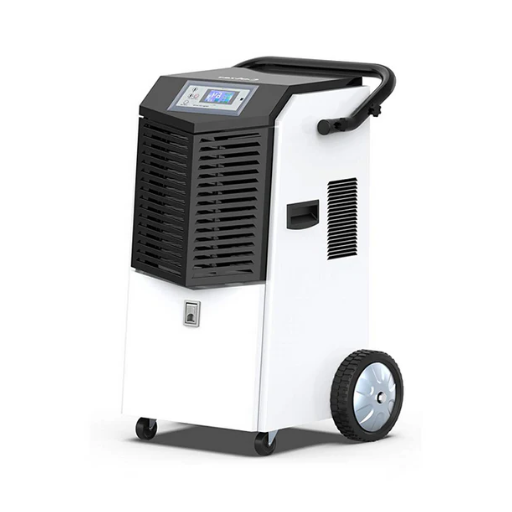
Where to find dehumidifiers for sale
When searching for dehumidifiers for sale, I suggest starting with specialized suppliers that cater to both commercial and residential purposes. A great site that everyone recommends is Wisdom Dehumidifier. It is a trusted platform that offers everything, ranging from high-performing industrial dehumidifiers. They provide product specifications with competitive prices and expert advice so that one can choose an option best suited to their particular requirements.
Besides this, marketplaces and e-commerce stores for industries and manufacturers provide a better ground to probe in. However, Wisdom Dehumidifier sets itself apart by not only listing items but also giving informative notes about every model, which helps grasp important features like capacity, efficiency, and settings. All this is very important to consider while investing ina precision equipment system meant for harsh environments.
Of course, don’t discount good customer support and warranties during your purchase. Using a platform such as Wisdom gives you access to knowledgeable professionals for recommending products that will best suit your needs. Whether you are in the business of water damage restoration, humidity control in a commercial setting, or simply enhancing residential air quality, good support and guidance will ensure you purchase the right equipment for peak performance and long-lasting durability.
Choosing between refrigerant and desiccant types
Dehumanizing refrigerating and desiccant dehumidifiers, and the artistry behind it, would help explain the motivation for efficiency in moisture control based on the specific situation. Refrigerant dehumidifiers cool the air moisture with the condenser coil, thereby causing the water vapor to condense into its liquid form. These are very handy in warm and wet climates that demand an efficient reduction of moisture. Usually, for instance, refrigerant models do better at temperatures above about 65°F (18°C) and are commonly deployed both in residential and commercial settings where there exists an excess of moisture.
While desiccant dehumidifiers dehydrate air moisture with a hygroscopic material like silica gel, they also work well at low temperatures found commonly for example in unheated basements, cold storage rooms, or cool climate areas. To that effect, desiccant dehumidifiers retain their operational efficiency at subfreezing temperatures and so are fit even under extraordinary situations. A study has revealed that desiccant systems tend to be the preferred ones for specialized industrial usages such as pharmaceutical storage and ensuring preservation of sensitive equipment.
In the end, because these appliances work in different environments depending on temperature and humidity, as well as their intended application, knowing just about their technical strengths allows users to make an informed decision concerning maximizing the efficiency and life of their equipment.
Why is moisture control critical in Industrial Settings?

Preventing mold and damage
In industrial settings, proper moisture control is an important parameter to consider to prevent the growth of fungi and damage to structures that can occur, checks to safety and operational efficiency. Mold grows when humidity levels are more than 60%, especially in poorly ventilated premises with organic materials, such as wood, paper, and textiles. Once mold takes shape, it begins to weaken the host structure, degrade materials being stored, and create health hazards for personnel that include respiratory ailments from airborne spores.
Moreover, metal surfaces and electrical components rust in the presence of excess moisture, resulting in expensive system failures and downtime. Some studies suggest that high humidity conditions for prolonged periods foster quick oxidation, shortening industrial machinery’s life span. With optimal relative humidity being anywhere between approximately 30% to 50%, industries need to ensure that these conditions are maintained to lessen the associated risks and protect their operations.
To create the right balance, sophisticated environmental monitoring systems, along with advanced dehumidification technologies, have been used successfully. For example, a desiccant dehumidifier can be installed wherever high-humidity climates prevail, whereas refrigerant-based dehumidifiers suit moderate environments, ensuring precise control customized to local conditions. The combination of these technologies with real-time data analytics enables facility managers to spot early indications of imbalance and intervene ahead of time to shield the sensitive assets and remain in regulatory compliance.
Impact on performance and equipment
The moisture content of an environment affects how well operations run and the longevity of the equipment. Having too much humidity or being too dry can create performance problems that cause some failures in equipment, thus decreasing the overall productivity of the plant and increasing maintenance costs.
- Corrosion of Metal Parts: The higher the humidity for long enough, the more it accelerates corrosion of the metals in the machinery through oxidation. It has been found that rust formation is very rapid when the relative humidity exceeds 60%, thus reducing the life span of metal parts by as much as 40%.
- Degradation of Electrical Systems: Water infiltration causes short circuits in electrical panels and circuits, thereby triggering malfunctions or failures in the equipment. About 25% of equipment downtime happens in industrial facilities due to moisture-related electrical faults.
- A Decline in Process Efficiency: Shifts in ambient humidity change material properties such as powder agglomeration in pharmaceuticals or warping in woods, causing delays and wastage in the production cycle. Research suggests there are an additional 15% costs due to material inconsistencies caused by poor humidity control.
- Wear and Tear of Seals and Gaskets: Under fluctuating humidity conditions or moisture extremes, seal and gasket performance is adversely affected in that it causes leakage or loss of pressure-resistance. Industrial data shows that improper humidity can reduce the working life of such components by up to half.
- Mold Formation and Contamination: Mold formation and mildew on the surface of equipment take place in a high-moisture environment, posing hygiene problems and threatening quality control of sweat products. Some 30% of contamination cases were ascribed to poor moisture control in a survey conducted in food processing plants.
Through these very important effects and the development of their solutions in advanced moisture management systems, a facility will be able to improve its performance, enhance the life span of its equipment, and greatly mitigate operational risks and costs.
The role of dehumidifiers in water restoration
Dehumidifiers in water restoration act as a dam against extra moisture. High humidity can do further damage to the structure; thus, their use is crucial in minimizing structural damage, furthermore, preventing mold and mildew from growing, and restoring a safe and habitable environment. Below are five major services dehumidifiers provide in water restoration:
- Moisture Removal from Affected Areas: Dehumidifiers remove moisture from walls and floors as well as from the air after water damage events such as flooding or leakage. Industrial units with a high capacity can draw 50 gallons of water in a day, thus facilitating a quicker drying process to avoid further damage.
- Prevention of Mold and Mildew Growth: Dehumidifiers keep relative humidity below 60% and prevent mold and mildew spores from developing. Research shows that mold can start growing within 24 to 48 hours following the water exposure; therefore, it is crucial to control moisture immediately.
- Preservation of Structural Integrity: Undertaking these operations would ensure that excess moisture would not destroy structural materials, including wood, drywall, and insulation. Dehumidifiers prevent warping of wood, crumbling of plaster, and failure of adhesives, which safeguards the structural integrity of the building.
- Enhancement of Indoor Air Quality: Restoration of water includes elimination of airborne contaminants from excess humidity, such as dust mites or allergens. It is an improvement of indoor air from dehumidifiers by lowering the humidity post-restoration.
- Energy Efficiency During Drying: In collaboration with air movers and heaters, dehumidifiers heat the drying process of restoration. Detecting moisture levels, they allow other drying apparatuses to work much more efficiently; thus, saving on time and energy consumption.
Thus, dehumidifiers directly serve as a money-saving factor during water restoration, in which long-term damage can be minimized through efficient, fast recovery.
Understanding the Different Types of Professional Dehumidifiers

Features of a 70 pint dehumidifier
Designed for heavy-duty dehumidification, a 70-pint type dehumidifier is most often used in situations wherein a moderate to severe moisture problem is faced. By removing up to 70 pints of moisture from the air in 24 hours under optimal conditions, this dehumidifier is suitable for much larger spaces like basements, warehouses, or commercial establishments. Some of the specifications for these dehumidifiers include:
- High-Efficiency Moisture Removal: High-quality refrigerant coils and compressors provide consistent dehumidification, even when moisture levels are high.
- Integrated Humidistat: The built-in humidistat allows for fine control and monitoring of the room’s humidity level, which is usually adjusted to the desired comfort and safety level.
- Energy-Efficient: Most of the energy-efficient 70 pint dehumidifiers use components that save energy; this way, they run while their cost in operations is kept to a minimum.
- Durable Construction: Made of heavy-duty materials to ensure a long life, especially for industrial or extended-time operations.
- Advanced Air Filtration: Some models can include washable or replaceable filters to remove airborne pollutants such as dust, allergens, and mold spores to further enhance the air quality, besides humidity control.
- Portability and Ergonomics: Generally outfitted with caster wheels, ergonomic handles, and a compact design for user-friendly relocation and use in different locations.
- Auto Defrost System: Its function is to stop frost from forming on the coils whenever units work in low temperatures, so the units perform consistently in a cool climate.
- Continuous Drain Options: These have facilities for continuous drainage through their pumps or gravity, so that one does not have to empty the water tank.
When purchasing the most suitable 70 pint dehumidifier for the home or office, consider the space where the device will be working, the power consumption, environmental conditions, and other factors affecting performance. Dehumidifiers are mainly used in moisture-prone sites for maintaining structural integrity, keeping mold away, and improving Indoor Air Quality (IAQ).
When to use a commercial dehumidifier with a pump
In situations where high humidity levels threaten structural stability, health, or operational efficiency, commercial dehumidifiers equipped with pumps become a necessity. These units are best suited for larger areas, such as warehouses, industrial operations, hospitals, gyms, and underground spaces where moisture control must be sustained. The internal pump allows for continuous drainage of water, even if the way of drainage is against gravity very important factor in places where draining by gravity is not acceptable or would require a huge effort to be set up.
This pump-type dehumidifier performs ideally when water damage restoration is in place, removing moisture from affected areas quickly and without human intervention. Recent studies and industry reports further emphasize that moisture control becomes paramount because humidity above 60% RH predisposes environments to mold proliferation, depreciation of materials, and corrosion of equipment. Data also indicates that the commercial dehumidifier with a pump saves another amount of manual involvement, thereby creating the impact of quicker operation and reduced maintenance cost in the long run.
Built tough for rigorous use in demanding conditions, these machines claim that they provide beginning-to-end remedies to difficult scenarios like disaster recovery, construction drying, as well as moisture control in sensitive storage facilities. Through consistent and powerful performance, commercial dehumidifier pumps deploy a reliable defense to protect assets, health, and infrastructure in moisture-critical environments.
Ideal applications for desiccant dehumidifiers
Desiccant dehumidifiers perform very well in environments where humidity control needs to be precise, or where low temperature makes conventional refrigerant-based machines less effective. The five applications below present opportunities in which desiccant dehumidifiers provide a tremendous amount of benefits:
- Industrial Manufacturing Facilities: Areas such as pharmaceuticals, electronics, or chemical production have manufacturing processes that are highly sensitive to moisture levels. This sensitivity requires precise humidity control by desiccant dehumidifiers to protect raw materials and finished products from any moisture-related damage or defects.
- Cold Storage and Refrigerated Warehouses: Condensation and frost buildup in a refrigerated environment can ultimately be a threat to product integrity. Desiccant dehumidifiers function below freezing temperatures to maintain favorable storage conditions for perishable goods and limit frost accumulation on the surfaces.
- Large-Scale Water Damage Restoration: In the case of flooding or major water damage, desiccant dehumidifiers provide powerful moisture extraction, especially in cold or unheated spaces, thereby shortening drying times and lessening structural damage and mold growth on buildings or affected assets.
- Military and Aerospace Storage: Sensitive equipment and materials such as aircraft parts and military hardware must have controlled humidity to prevent the onset of corrosion and degradation. Desiccant dehumidifiers provide for the active preservation of dry conditions, thereby sustaining the service life of critical components already in high-moisture environments.
- Cleanrooms and Laboratories: Environments such as cleanrooms and labs require tight humidity control to ensure sterility and keep experiments or production precise. Desiccant dehumidifiers allow low relative humidity to prevent contamination, assure product quality, and facilitate scientific accuracy.
These applications highlight the versatility and effectiveness of desiccant dehumidifiers in maintaining optimal moisture conditions across a wide range of industries and use cases.
References
-
Eliminating Humidity and Condensation Problems in University Dormitories- Case Study – A case study discussing humidity management in crawl spaces.
-
Energy-Efficient Management of Mechanical Ventilation and Relative Humidity in Hot-Humid Climates – Research on managing humidity efficiently, including crawl space considerations.
-
Optimizing Energy Efficiency and Improved Dehumidification Performance of Variable Capacity Air Conditioning Systems – A study on energy-efficient dehumidification systems, mentioning crawl spaces.
-
Comparative Study of Vented vs. Unvented Crawlspaces – A comparative analysis of crawl space designs and their impact on humidity control.
-
Evaluation of Crawlspace Retrofits in Multifamily Buildings – An evaluation of crawl space retrofits and their effectiveness in managing moisture.
Frequently Asked Questions (FAQ)
Q: What factors should I consider when choosing the right industrial dehumidifier?
A: When selecting an industrial dehumidifier, consider the size of the area, the level of humidity, the specific environment (such as a crawl space or a basement), and the capacity needed to effectively reduce moisture levels. It’s also important to consider energy efficiency and ease of maintenance.
Q: How do I determine the size of the dehumidifier I need for my enterprise?
A: The size of the dehumidifier depends on the square footage and the humidity level of the area. Larger spaces or areas with high moisture content will require a dehumidifier with higher capacity. Professional assessments can help determine the exact requirements for your enterprise.
Q: Why are commercial dehumidifiers recommended for industrial use?
A: Commercial dehumidifiers are designed to handle larger spaces and higher humidity levels typical in industrial settings. They are more robust, durable, and efficient in moisture removal compared to residential models, making them suitable for enterprise use.
Q: What are the benefits of using a dehumidifier in a crawl space?
A: Using a dehumidifier in a crawl space helps to prevent mold growth, reduce odors, and protect the structural integrity of the building by controlling moisture levels. This can improve air quality and reduce maintenance costs over time.
Q: Can I use a residential hose for basements with a commercial dehumidifier?
A: While you can use a residential hose, it is recommended to use a hose specifically designed for commercial dehumidifiers to ensure proper water drainage and to prevent leaks. These hoses are typically more durable and fit securely with commercial models.
Q: How do dehumidifiers reduce energy costs in industrial settings?
A: Dehumidifiers reduce energy costs by maintaining optimal humidity levels, which can improve the efficiency of HVAC systems. By reducing the workload on these systems, energy consumption decreases, resulting in cost savings.
Q: What maintenance is required for an industrial dehumidifier?
A: Regular maintenance of an industrial dehumidifier includes cleaning the filters, checking for any hose or drainage issues, and ensuring that the coils are free of dust and debris. Routine maintenance helps extend the life of the product and ensures efficient operation.
Q: How often should I run my dehumidifier in an industrial setting?
A: The frequency depends on the specific humidity levels and environmental conditions of the industrial space. In general, running the dehumidifier continuously in high-humidity areas can be beneficial, but it’s best to monitor humidity levels and adjust usage accordingly.

